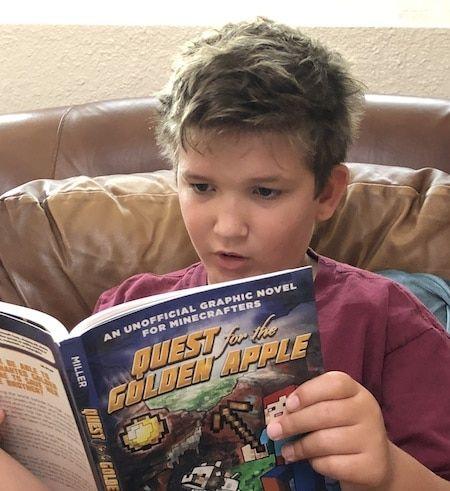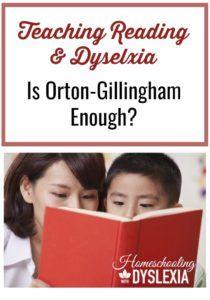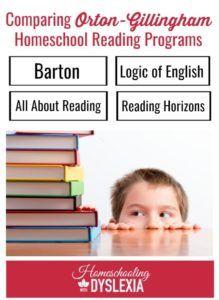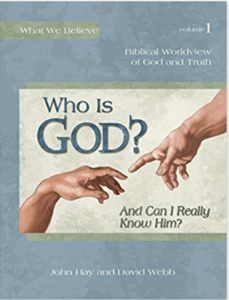Homeschool curriculum picks for our houseful of kids with dyslexia.
This post may contain affiliate links. See disclosure.
I always get confused looks when I declare how easy it is to homeschool four kids with dyslexia. It’s all relative folks! After homeschooling/parenting eight kids with learning differences for so long, teaching four seems like a walk in the park!
This year our homeschool consists of a 10th, 8th, 6th, and 3rd grader. This will be our 5th year participating in the Classical Conversations (CC) homeschool co-op. We joined after being encouraged that CC actually is an excellent fit for kids with dyslexia. You can read more about what Classical Conversations is and if it is a good fit for kids with dyslexia here.
Middle and High School Curriculum
The 10th (Challenge 1) and 8th (Challenge B) graders are working largely independently through the upper levels of Classical Conversations – thank you assistive technology! Besides a constant battle with focus, planning, and procrastination caused by ADHD, with an hour or so a day in oversight, I can rely on the older two to complete their work most weeks. I’ll share next week about how we set up the girls’ weekly planners and how assistive technology plays a role in their independent learning.
Other posts on middle and high school:
How to Homeschool Your 7th Grader (also good for any middle school grade)
Preparing for College Success Series
Homeschool Morning Time Plans

Several years ago I wrote about morning time at our house. I love it so much, I call it my favorite homeschool hack. Morning time is when we all sit around the living room or family room (or wherever we end up) and run through a variety of subjects together.
First of all, it is a wonderful time to connect as a busy family and second, it is an enjoyable and efficient way to regularly get to those ‘minor’ subjects that we wouldn’t normally get to as we struggle to get to the reading, spelling, writing, and math lessons every day.
Here’s what our Morning Time plans look like so far:
Bible Curriculum
As Christians, I want my kids to understand God and their relationship to Him. By far, the best curriculum we’ve ever used to do that is the Apologia worldview series. Soundly biblical and engaging (even for mom).
It’s a 4-volume set of story-based instruction. This year we’ll be starting over at the beginning of the series with Who is God? And Can I Really Know Him? Other books in the series are Who am I?, Who is my Neighbor?, What on Earth Can I Do?
History, Science, and Geography Curriculum
Our core curriculum for History, Science, and Geography for the elementary-aged kids will be the Classical Conversations (CC) memory work. This strategy is a win-win for several reasons.
- Memorizing facts about history, science, and geography is developmentally appropriate for an elementary-aged child. We’ve trudged through complete history or science curricula in the past, only to have the kids forget most of what was taught. The truth is that their brains aren’t wired yet to make a ton of connections and meaning from these areas of learning. Memorizing vocabulary from these strands provides exposure to a wide variety of key ideas – and this is enough for this stage of learning.
- The other reason using CC memory work for the core of our history, science and geography study is that it is actually doable. As many of you know, finding time to give our kids the individualized teaching that they need is a constant struggle. Letting go of my traditional school experience and expectations means that my homeschool is much more peaceful and focused on priorities.
Read more:
How to Choose a History Curriculum
How to Choose a Science Curriculum
Read Alouds
Reading good books out loud as a family provides so much value, yet for me, it can be hard to make time for. Making a habit of reading aloud during our Morning Time helps with that. Using audio books helps too.
For our read alouds we alternate listening to the Story of the World which we love, love, love and reading (listening to) and a variety of books from my must-read list and historical fiction.

A Not-so-Quick Word About Burnout
As a longtime (over 20 years) homeschooler, I’ve experienced a whole new variety of homeschool burnout. Teaching my kids isn’t the new and exciting adventure it once was. On the one hand this is a good thing because I have a lot more experience and can save a ton of energy because I know what works and what doesn’t. But on the other hand, it saps my motivation in a major way.
I overcome this lethargy by making a priority of our ‘morning time’ (it’s all about habits, mama!), belonging to and committing to a co-op for accountability and community, hiring tutors when we can afford to, and using audio books so I’m not the one reading. Something about being an introvert in a houseful of noisy talkers makes this very tiring for me – weird, I know!
Homeschool Language Arts Curriculum for Dyslexia
Total disclosure: my 11-year old profoundly dyslexic sone, despite years of Orton-Gillingham reading instruction and tutoring, was still testing at a 1-2nd grade reading level at the end of last school year. What? How? This kind of disappointment never gets easy even though I know that his dyslexia is on the severe side and this learning curve is normal for that.

Yes, he needs a hair cut!
Well, this summer (when, I might add, we haven’t done ANY formal reading instruction) he has been reading a TON! He picks up books everyday and will sit and read, read, read. He can’t read all of the words and sometimes he ends up looking at the pictures but he is reading a TON out of a desire to read. LOVE, LOVE, LOVE. Lesson learned: Hang in there, they will learn to read, even though sometimes it seems like they never will!
If you have an emerging reader who likes Minecraft, you will love these graphic novels.
How We’re Teaching Reading This Year
Of our 7 kids with dyslexia, only two still need remediation. Yes, there is a light shining at the end of this tunnel! The rest of our school-aged kids are reading well and learning mostly independently with the help of assistive technology.
 Our two sons (8 & 11) who are still not reading fluently, are both seeing an NILD.org educational therapist. We discovered NILD when we were looking for help for our profoundly dyslexic son about 10 years ago. This program is incredibly powerful because it addresses the underlying weaknesses found in all kids with learning struggles: working memory, auditory processing, visual processing, and executive function skills. We moved our current profoundly dyslexic son to NILD 2 years ago because his progress with a straight Orton-Gillingham program was so slow. Read more about why Orton-Gillingham may not be enough for your dyslexic student here.
Our two sons (8 & 11) who are still not reading fluently, are both seeing an NILD.org educational therapist. We discovered NILD when we were looking for help for our profoundly dyslexic son about 10 years ago. This program is incredibly powerful because it addresses the underlying weaknesses found in all kids with learning struggles: working memory, auditory processing, visual processing, and executive function skills. We moved our current profoundly dyslexic son to NILD 2 years ago because his progress with a straight Orton-Gillingham program was so slow. Read more about why Orton-Gillingham may not be enough for your dyslexic student here.
 If you’re not in a place where you feel the need to hire a dyslexia tutor or educational therapist, you can read my reviews and a comparison of my top 4 favorite open-and-go Orton Gillingham reading programs here.
If you’re not in a place where you feel the need to hire a dyslexia tutor or educational therapist, you can read my reviews and a comparison of my top 4 favorite open-and-go Orton Gillingham reading programs here.
All of these programs also address how to teach spelling.
New to the homeschooling kids with dyslexia scene? Read my 5-part series on How to Teach Reading to Kids With Dyslexia here.
Additional Reading Resources We’re Using
Learning Ally – an excellent an affordable resource for listening to books while following along on tablet or device. Get a free referral to Learning Ally from All About Reading here.
Audible– an amazing resource for high quality audio books.
Reading Horizons – online Orton-Gillingham reading and spelling program for older (10+) kids. See my Reading Horizons review here.
Touch-type, Read, Spell for typing. (TTRS) teaches touch-typing skills in ways that also help kids improve their reading and spelling. It does that, in part, by having kids drill with actual, carefully selected words (red-led-fed), rather than purely mechanical keystroke combinations (juj-kik-lol, etc.).
Writing and Dyslexia
My 11-year old will be taking a writing and grammar course as part of our Classical Conversations community. This will be his 1st time to work all the way through IEW Teaching Structure and Style writing program. It was overwhelming to him in the past as a non-reader.
Because IEW was too overwhelming for my non-reader last year, we substituted with WriteShop Junior at home with great success. You can read about our experience teaching writing with Write Shop here.
All Things Fun and Fascinating: My 8-year old will be using All Things Fun and Fascinating writing program from IEW. This is an introduction to the IEW writing method. It starts out with short, simple, easy to outline stories and is a way for him to get used to writing in a fun and gentle way.
Fix-It Grammar: This was recommended so many times by my readers that I took the time to check it out at a homeschool conference this year. Fix It Grammar teaches grammar and vocabulary in an ingenious way by having students hunt for and correct errors in daily passages that cumulatively tell a story. My older kids will also be doing a higher level of Fix-It Grammar for a review.
Poetry Memorization: We’ll work on a few more poems from the IEW Poetry Memorization program this year as time allows. The poems are fun and interesting and make for great presentations for the kids.
Handwriting
Rhythm of Handwriting: We’re big believers in teaching our kids to write in cursive. The Rhythm of Handwriting by Logic of English is an amazing, inexpensive, multi-sensory approach to teaching cursive to kids as young as 5. Read how and why we teach cursive first in our homeschool.
Typing
We purchased a subscription to Type-type, Read, and Spell at a steep discount from Homeschool Buyers Co-op and will continue to use it with our son with dysgraphia. His continuing difficulty with handwriting in any form (even though he is mastering cursive) means it is time to introduce typing as an accommodation in the form of assistive technology. TTRS teaches keyboarding following a similar phonics progression as an Orton-Gillingham based reading program and provides practice in typing as well as reading and spelling.
Homeschool Math Curriculum

With my youngest officially in 3rd grade, all but one of my kids are using Teaching Textbooks this year. The one ‘rebel’ asked to use Saxon for Pre-Algebra so she can be on the same schedule as the other students in her Classical Conversations class. This should be interesting!
Read my review of Teaching Textbooks and why I think using TT is like having the good math teacher every year here, and my review of the newly released Teaching Textbooks 3.0 here. There are some amazing features in the 3.0 version so be sure to check them out!
Math Supplements
Times Alive: We’ve been working on learning math facts for the past week with Times Alive from CityCreek app on the iPad. Times Alive uses funny stories to help students remember their multiplication facts via video through their app (or on the computer).City Creek offers times tables and addition programs using pictures, stories, and songs.
We love this series of math fact books from Kate Snow at Kate’s Homeschool Math Help. This is a step-by-step guide to understand and memorize division facts with hands-on activities and fun games.
If you have kids who struggle with math, here is a list of 100 Resources for Kids who struggle with math.
How We’re Going to Get Things Done
After attending my kids’ CC Challenge class orientations, I realized that I am not going to be able to fly by the seat of my pants as far as scheduling goes. I’ll be posting soon on how we organize ourselves to get the most out of our days.
Were there any surprises on this list? What homeschool curriculum do you recommend?
For more tips on Choosing Homeschool Curriculum, read this epic post!
And this Grade-by-Grade Guide to Choosing Homeschool Curriculum.









I’m interested in the Touch-type Read and Spell. We’re already doing Reading Horizons on the computer though. Is there overlap between the programs though? Or is Touch-type truly a typing program (as Reading Horizons is not). I just don’t want to go overboard, but I do need them to learn to type too. Also, how long are the lessons, approximately?
Thanks for the feedback!
Hi Danielle. The lessons are quite short – only 5-10 minutes. TTRS would be review but not a replacement for Reading Horizons. It really is a typing program but the way it is structured using word families, reinforces spelling as well.
Thank you for this post and your recommendations. We are using TTRS and Fix it too. Do your Challenge age kids participate in morning time? I have two in Challenge and one in Foundations/essentials.
Not at this time. It takes them much of the day to get their Challenge work finished!
I know this was a huge post to write out so I want to say Thank You!! A lot of those links are things I’m going to keep looking at. I totally second TTRS for typing. My son does 1 module a day but has really done well in his practice-and is making his own newspaper with a neighbor friend to sell on the street instead of lemonade!
As far as cursive–is there a reason you prefer LOE instead of HWT? Or is it six one way half a dozen the other?
Price and ease of use are the main things.
Created for those in need of a little help reading. We are read in every country in the world for over 400,000 hours a year…are in at least dozens of schools, elem-university level.
On youtube at https://www.youtube.com/readalongclassics and https://www.youtube.com/listenandreadalong are over 3500 videos read by humans that are synchronized text to audio. It includes a 220 video(15 minutes each) complete set of the history of the US, English lessons(around 8 minutes each), a daily news update from Voice of America(5 minutes long) and much more.
Most videos are Voice of America or Librivox.org material. Most popular videos are the 20 songs we have posted(Playlist is here: https://www.youtube.com/watch?v=VtdC4If0tyM&list=PL5Zc8v096OOln5ZeAmoQAWdOPrEIpc8dY)
No ads, no charge, just reading stuff.
As a SAI I appreciate your recommendations/opinions! Thank you!
Wow! Thank you SO MUCH! I know God lead me to your site. I needed some ideas for my son and you shared all of your ideas and secrets. Thank you again and again.
Do you recommend an online schooling option?
I have heard good things about Accellus Academy. They have classes for struggling students as well.https://www.acellusacademy.com/